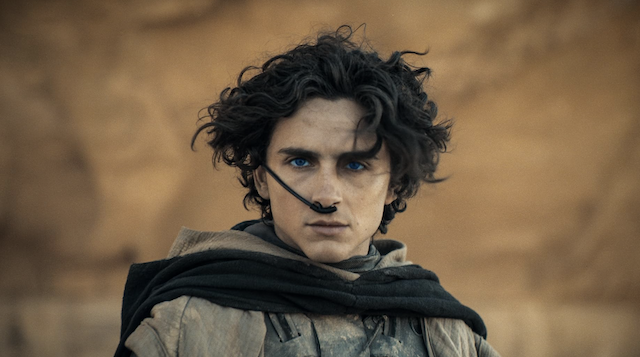
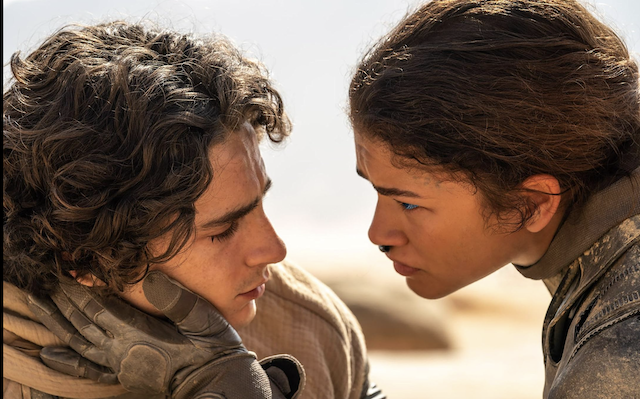
©Warner Brothers Pictures
Dune: Part Two / Q&A with Director Denis Villeneuve
Q: You are concluding your adaptation of Frank Herbert’s original novel. As you look back at both of these Dune films, what’s something that you learned making Dune Part One that was instrumental in the way that you approached making Dune Part Two?
Denis Villeneuve: Everything was instrumental, but I kept joking with my film crew that Part One was like a massive rehearsal to do Dune Part Two. When we started the process, we felt confident, we knew the alphabet, knew the world, the romance was being defined, everything. But [Dune 2] was a much more ambitious project. It was a beast.
There were a lot of challenges and I really pushed my crew. It’s interesting to be a great pioneer about how everything we had to develop — it was a massive challenge. I stuck to the idea that I wanted to shoot with natural light, which is not in the real desert and was not easy for the crew.
Q: Let’s go to the desert and talk a bit about sand, not necessarily how much sand you had in your shoes at the end of them getting banged — though surely it was a substantial amount. You shot Dune Part Two primarily in the deserts of Abu Dhabi. Talk about what you learned about sand, what was something unexpected that you discovered about it, both in staging the big sequences, but also with the very personal, intimate sequences, not just on sand, but within the desert landscape?
Denis Villeneuve: At first, I discovered that I was out of shape. No, but it’s exhausting to work in those conditions, and it’s like, to state the obvious, we were shooting in a real environment.
There was a certain period of time, specifically on Part Two [that we had to shoot]. For Part One, we had access to shade, but with Part Two, we spent weeks in the deep desert, and there’s a part of the day, two hours between 11:30 and 1:30, where your brain starts to boil like a bowl of soup. Everybody becomes a bit stupid, including myself and the crew. I knew at that time that I had to make sure that we had the right amount of water, not to be so ambitious at this time, because it was too warm.
Shooting in the sand is like shooting in the snow. You have to deal with ridiculous challenges, like footsteps, it required a lot of discipline within the crew, because the way we shot it, we began using natural light, which meant that we had to choose a specific spot in the desert that was perfect for certain close-ups.
And for the wide shots, we chose another set of dunes according to the sun positions, and to make sure that those would stay pristine. We had to own the desert. Technically, we had to make sure that the crew respected [the conditions] — and those are huge crews. If you have more and more people to take care of, it becomes like a little army.
The shooting of Part Two was different from Part One, in that there were more action scenes in the desert. In order to maximize our schedule, we used a device, a software, that was great, because it was capturing all the environments virtually, like the opening sequence, when we step by that fight, and the reality happens in maybe 16 different locations, let’s say, we have to, because we do a shot, and to do the reverse, to have the right sun position, we have to move the whole crew to a different spot, and to have the perfect timing for it.
On November 3rd, at 9:45, if you want to put Rebecca Ferguson with a rock smashing at Arrakis, we had to be there at 9:45 to have the perfect sun position. all the schedules were designed this way, I thought it was interesting to see that the computer we were using print like that, the sun patterns. It made our shoot an incredible puzzle for my first AD, but very efficient for cinematography.
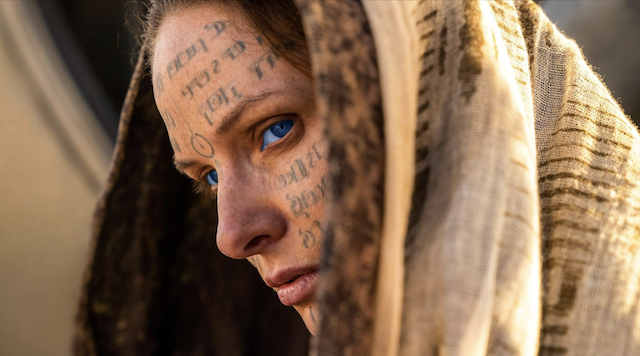
©Warner Brothers Pictures
Q: Towards the end of the year, a lot of people were sharing their favorite shots from the film on social media. Most of the shots were from Part Two, but there was one shot in particular, a lot of people kept sharing, the shot of the Harkonnen soldiers, walking off the cliff and floating. You have this like deep burnt red behind them. How did you execute a shot like that?
Denis Villeneuve: The idea in the book is this idea that you might be master of gravity, that they can then use a suspensor system, for lighting, or for vehicles, or also for, you can have portable postman system that allows you to defy gravity, but there’s no mention of how to move with those systems. I love the idea that like in dreams, you fly in scuba diving, the whole idea was to do scuba diving in the desert, defying gravity, and those are images came as I was writing the screenplay, and it was something exciting about it for me.
It reminded me of the movies I loved from the ’70s, the old sci-fi movies, and the way to do this was to do it as much as possible on camera. We had an immersive, fantastic stunt coordinator that created those rigs, with wire rigs, where we were actually having stunts flying on cliffs, with those, and the rest is a bit of CGI, but it’s quite, I was quite excited by the result of it.
It captured that idea of strangeness that I was looking for, that you feel you are with an alien technology. Most importantly, I was in love with the idea that we feel that the Harkonnen soldiers are foreigners, alien to this world. The Harkonnens don’t adapt, they just colonize, but never adapt to the environment where they are. that’s their main weaknesses, and I tried to express that in this first sequence.
Q: You spoke a bit about sunlight, the way you used light, not just on Arrakis, but also with the black sun of the Harkonnens. Did you have a general approach? With the opening sequence, it felt like it was at sunset. Then you had that big stage sequence where they’re fighting the [spice mining] machine. They’re running underneath the shadows of the wings coming down from the ship. Did you know, as you were writing [this sequence], what time of day you wanted these to be shot? What was your general approach?
Denis Villeneuve: Light is, of course, our ally in naturalism, and our ally in, if we had shot the whole movie at noon, it would have been like a blend. I was trying to create contrast. I was trying to create a dynamic contrast in the movie with a color palette of different time of day, different than the movie, with an eclipse, something unexpected that will shake the audience right at the beginning, aesthetically, and create vivid colors that will soon disappear, dissolve, and go back to the Arrakis we knew.
Each sequence was written according to a specific time of the day to sustain a dynamic effect, and each sequence will have its own identity, and to create a sense of aesthetic propulsion of an epiphyseal.
Q: It felt like those deep oranges, and those deep grains were really important to you as well.
Denis Villeneuve: Right. I love to work with cinematographers that aren’t afraid to burn the boat right at the start. We shot with filters, we did a tremendous amount of research with filters, so we shot with those filters at first to create that look that will emulate the idea that they are fighting under an eclipse. The Fremen will attack when the eclipse is at its darkest moment, the idea was that the Fremen use nature as their ally. What is crazy is that, of course, I wrote that in my office in Montreal.
When we came to Germany, we shot the actual sequence, there was an actual real eclipse appearing on the day of shooting. That was mind-blowing. When the eclipse happened, it was a partial eclipse, not total, but still, it’s quite a coincidence. I stopped the shoot, and we put all the cameras we had on it. The real eclipse is in the movie, actually, and that was when I knew the gods of cinema were with me! [audience applauses]
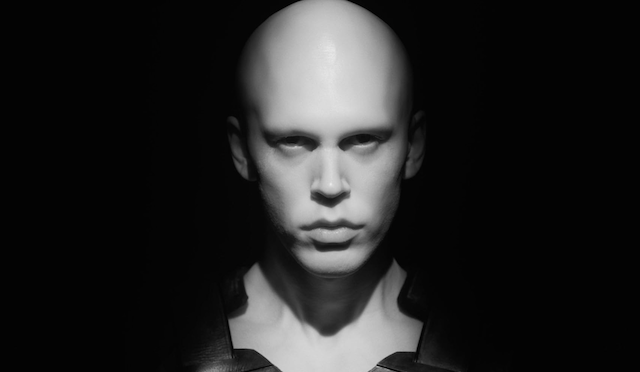
©Warner Brothers Pictures
Q: The languages, not just of the Harkonnen, but of the Fremen as well, are so authentically woven into the film. What was your general approach to the languages in terms of creating them, and when you decided to weave them into the narrative?
Denis Villeneuve: The main languages are part of the book. It’s a very important part of it, one of the beauty of the book is different cultures, and specifically the Fremen culture, how it is explained and explored. The Fremen culture and its language, there are a lot of hints of that language in the book. We hired a linguist, David Peterson, who developed the language. It’s all syntax, grammar, logic, poetry.
For example, when Chani says to Stilgar, “You are insane,” in Chakobsa, she says, “You drink sand.” That’s an expression of insanity for a Fremen — to drink sand. The language was very sophisticated like that, and each actor who went with the Fremen, [had to learn] Chakobsa, to pronounce each word and sentence. There was a translation, so what Timothee Chalamet does is [speak it].
In the end, each Fremen tribe knows exactly what he’s saying, it’s not gibberish. They’re real words that mean something real. He can have roots, and he puts his intentions and emotions in the right place. We interpret that language, and it really moved me to see the amount of commitment each actor had to really learn the language.
We had a dialect coach on set who was there to make sure that the pronunciation would be right. I thought about that earlier in the press tour. It gave some crazy moments where I was super happy with the shot, and Fabien, the language coach, came on set, and said, “Actually, the pronunciation of [some specific word] was not exactly correct, we should do another take.” I said, “come on, dude, it’s a fake language [audience laughing].”
I actually adore all the crew and actors, they took that seriously. We did the same with the Harkonnen language, but it’s a little less elaborated, to be honest, but the idea that we could both chant, we could both chant in the arena, it’s all about culture, culture clash, and different visions of the world expressed through language.
Q: You mentioned the arena, that’s another glowing moment in the film, and it shakes you out of being on Arrakis when we go there. Talk about setting up that arena sequence, and what it was like to film that. Also, talk about Austin Butler — what did you see in him that convinced you that he can play, not just a psychopath, but a psychopath that has a vulnerability to him he’s trying desperately not to expose.
Denis Villeneuve: There’s a lot of cues about what the arena looked like in the book, that idea of a wide set, triangular arena with the shape of the doors, but one thing I love about the book is how Frank Herbert is studying the impact of the environment on people, how it defines, how your ecosystem defines your culture, religion, habits, behaviors, poetry, et cetera. And there’s a lot there.
When you look at the desert, you understand the Fremen, you know about the Fremen, the correlation between the environment and their culture. But for the Harkonnen, there weren’t a lot of hints that their planet destroyed the environment, that it’s an industrial planet, so I said, what would be the clue that my toolbox [could use to] express?
I wanted a black and white [look] that would have a single arc with the light that feels alien. It’s a great game with the idea of infrared cameras. Infrared usually is something that digital cameras are designed to block, so it’s like a noise, but we did the opposite, Greg played with the software, and let just that kind of light come in.
It created that beautiful, eerie black and white where we see through the skin, the eyes are very piercing, insect-like, and the only thing with that is that you can’t go back. When you shoot with that, it’s in the eyes of the studio, you understand. You’d better love it. I love the fact that they don’t operate in fear, they trust us, and we shot the whole sequence with those devices, with those cameras, to create that alien look that I really love.
Now, about Austin Butler. He’s as tremendous an actor as I’ve seen. Baz Luhrman shared with me — he’s some part of Elvis, I was very interested in him, and was floored by how he portrayed the king. I saw it as a potential to bring someone that would have the necessary sex appeal, and presence on screen, and I’m very proud of that. Honestly, he’s one of the best actors I’ve worked with, he’s a tremendous force, he’s really a force.
He’s someone who is willing to try different things.Since Austin and I are not psychopaths, we have to explore how we express that, how we approach it. It involved moving a lot, playing with the way you walk and dance, the way Austin came up with the idea that, which I love, he should express himself with an accent that’s close to Stellen Skarsgard’s Swedish accent.
I love this accent. He developed some tics together that, when he gets excited, [he has a] kind of orgasmic laser twitch that I love. You choose someone and hope [it’s the right move.] It’s all theory until you put all the ingredients in front of the camera, and say, “Action.” I remember when Austin did his first shot, and I was like, “Oh, thank you.” I don’t even know, but it’s a character that is one of the most famous characters of all. He had big shoes to fill. I was really proud of him.
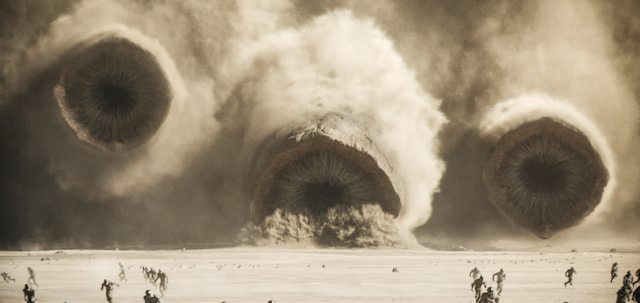
©Warner Brothers Pictures
Q: Talk about casting Timothee Chalamet, you brought him in for both films. What did you see in him originally that convinced you that he could become what he does at the end of the day?
Denis Villeneuve: Timothee has this incredible beauty in his features. He looks 16 years old for Part One, but he’s also a very old soul, having that heritage of half-French, half-American. Having all that cultural background, he’s really a thoughtful, brilliant, deep actor, someone that’s much older than what he is, an old soul.
I had seen things in his past work where I saw what he can do and that, when he grounds himself, he becomes a giant in front of the camera. For the first movie, I kept bringing him down, I kept saying, “Timothee, not now, you’re not Muad’Dib yet. In the end, you have to stay young.” I have to keep his youth to play with the power of his youth. But for the second one, I went the opposite, and exploited, if I can use that word, his darkest and more mature side.
Q: A few months ago, Timothee told the story about how you weren’t crazy about him speaking the language in that final speech, you didn’t know if he had it in him. He thought that he was going to have to do it in English, but you told him that you wanted him to do it in the [native Dune] language Chakobsa.
Denis Villeneuve: It was a difficult scene, and I wanted to make sure to give him all the tools to be able to bring it home. We did it in English and Chakobsa. He blew my mind when he did it in Chakobsa, because there was so much subtlety and complexity that I wanted to make sure that everything would land, but it wasn’t interesting by doing it in English, then it’s like finding the right emotional road to it, and then we did it in Chakobsa and he blew my mind. It required a lot of time to be able to perform such a scene in a fake language.
Q: Zendaya also does a tremendous job. It was really interesting how she’s quiet for that last quarter of the film, she doesn’t really say anything. It’s all in her face and expressions. Why did you think Zendaya was right for the role? Talk about her finale in Dune Part Two, and how you approached it.
Denis Villeneuve: I love actors who are good listeners. That’s something that fascinates me. I made a whole movie about that, people listening to the other, just reacting to what the relations of the truth that’s being displayed to them, and to see the reaction. It’s a thing that I love about Zendaya, her capacity to express herself just with her eyes, and to go to a range of emotion or ideas, just with her very minimalistic, precisely used expressions.
I knew she had that inside her. I had worked with her on Part One, and knew she had that capacity. We did some experimenting on Part One, with Zendaya, where I spent a day with her in the desert, and I was there with her, just shooting elements for the false vision, and I was so impressed by her flexibility, how daring, how, she has no fear, and she, an incredible ability to play with the zone of the — how can I say that in English — imagination, where it’s unrelated to reality, but to go in the subconscious zone, and where she grounds that, and bring that home.
It was very important for me for this final act of the film to be perceived through her point of view. The Chani character is different in the book. In the book, she’s walking in false shadows, she’s a believer, but I gave Chani her own agenda. I wanted her to become a moral compass at the end, so the movie would be perceived as a cautionary tale, and that the celebration of polarity is no more a warning, I guess, compared to what I had figured.
It was Frank Herbert’s idea to do that, I didn’t have to do that in the first book, but it was definitely a factor, like, it was received, and he wrote a second book called “Dune Messiah,” to correct that perception, where we understand that Paul made the wrong choices. I wanted to feel that at the end of Part Two, that the idea would blend more precisely, and I used Chani for that, and that is why I put a lot of pressure on Zendaya on that third act.
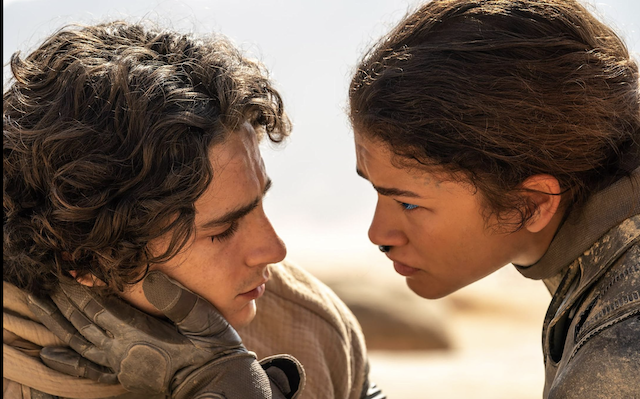
©Warner Brothers Pictures
Q: You say that you feel like your adaptation is more loyal to Frank Herbert than it is to the book itself.
Denis Villeneuve: Exactly, for those reasons, I feel that, I hope, with humility, that he would have been happy with this idea of giving Chani more substance at the end, and that she becomes our point of view of what the journey that Paul actually is embracing is the wrong one. He becomes a colonizer himself, and that’s his one, and yet her heart is betrayed, but her ideals are betrayed as well.
Q: It switches kind of perspective, and we are seeing the story now through her eyes at the end, because it’s like, our hearts are also breaking. This is a character we’ve been rooting for as well.
Denis Villeneuve: Yeah, it’s really one of the big differences between the book and the most important, and definitely something that I’m very happy with.
Q: Talk about the sound on this film, the score from Hans Zimmer. What early conversations did you have with Hans about the score, and what you wanted it to sound and feel like?
Denis Villeneuve: The thing is that the soundtrack is really the continuity from Part One. In a way, part one and part two, it’s one big movie that’s cut in half. That was absolutely against the decision of the Academy to exclude Hans Zimmer. Frankly, I feel that his score is one of the best scores of the year, that it has a tremendous personality, but it’s rooted in Part One, of course, because it’s a continuity. But I’m not here to complain. [Audience chuckles.] I absolutely love this artist. I don’t use the word genius often, but Hans is one.
His ambition was to create an alien score with a heartbreaking love theme. I remember, the only time I saw Hans nervous is when he talked about the love theme. When I said to him, “What would be something important for you? I would love for you to write something that would break our heart about that love, that young woman who falls with this young man. That young man falls in love with a girl in their culture, and, at the end, the whole movie is structured around their love story.” He became pale and said, “those are the most difficult to write, I tell you.”[audience chuckles]
He did something that’s tremendously remarkable — that love theme at the end. It’s exactly what the movie needed. Hans has been my partner since day one when I embarked on the journey of making the Dune movie. The first artist I contacted was Hans, and knew he loved the book. He really wanted to work with me on this project, and is someone that has known the book by heart.
He was my closest ally in discussing the underlying layers of what the movie meant, and was able to help me with the music to bring out that sacred quality that I was looking for, that spiritual aspect, and also the alien feeling. I’m really in love with that score. Frankly, it’s a privilege and honor for me to have the chance to work with Hans on both movies.
Q: As you step away from these two films, what are you personally most proud of?
Denis Villeneuve: It’s a difficult question. when you finish a film, as a film director, you don’t know what you get, but I feel that it’s a cross-mix between pain, joy, failure and success. You see more of the failures than successes, and you just say to yourself, “I’ll do better, I’ll be better next time.”
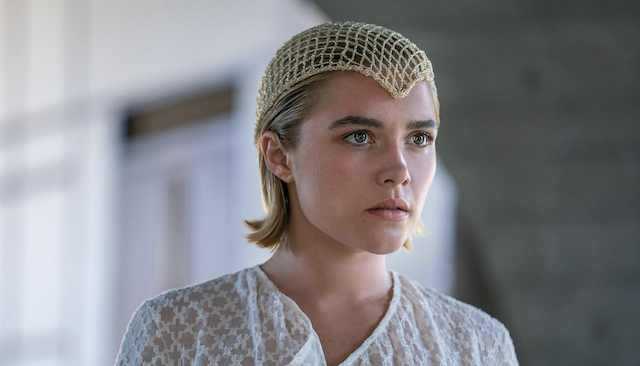
©Warner Brothers Pictures
If you like the Q&A, share your thoughts below!
Check out more of Nobuhiro Hosoki’s articles.
Here’s the trailer of the film.
![]()

